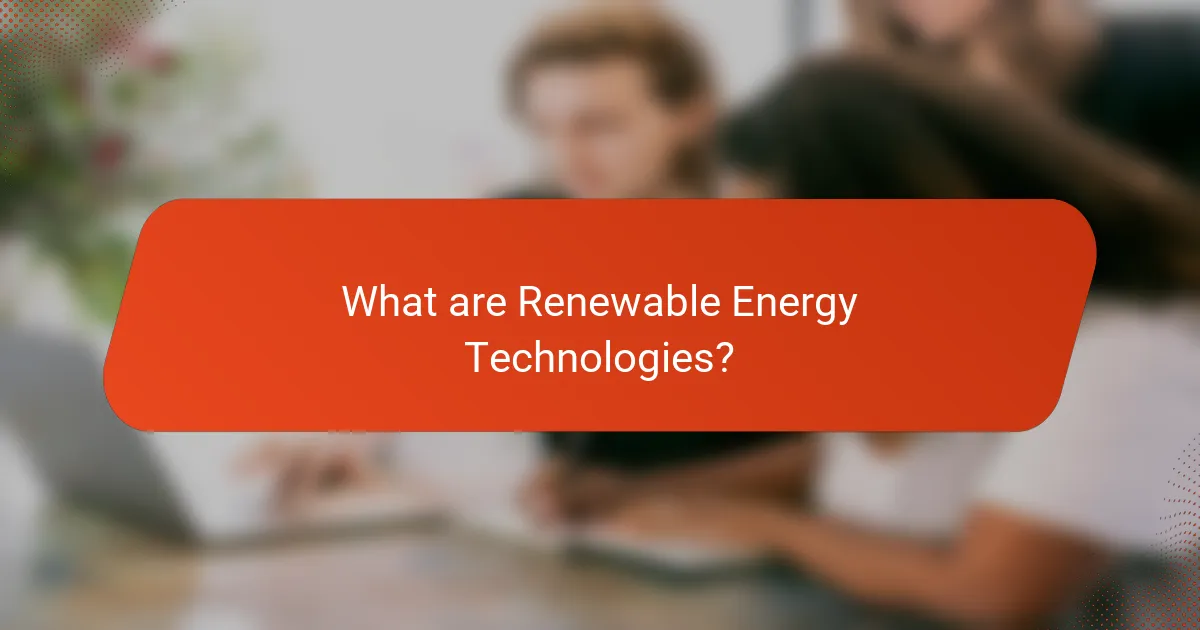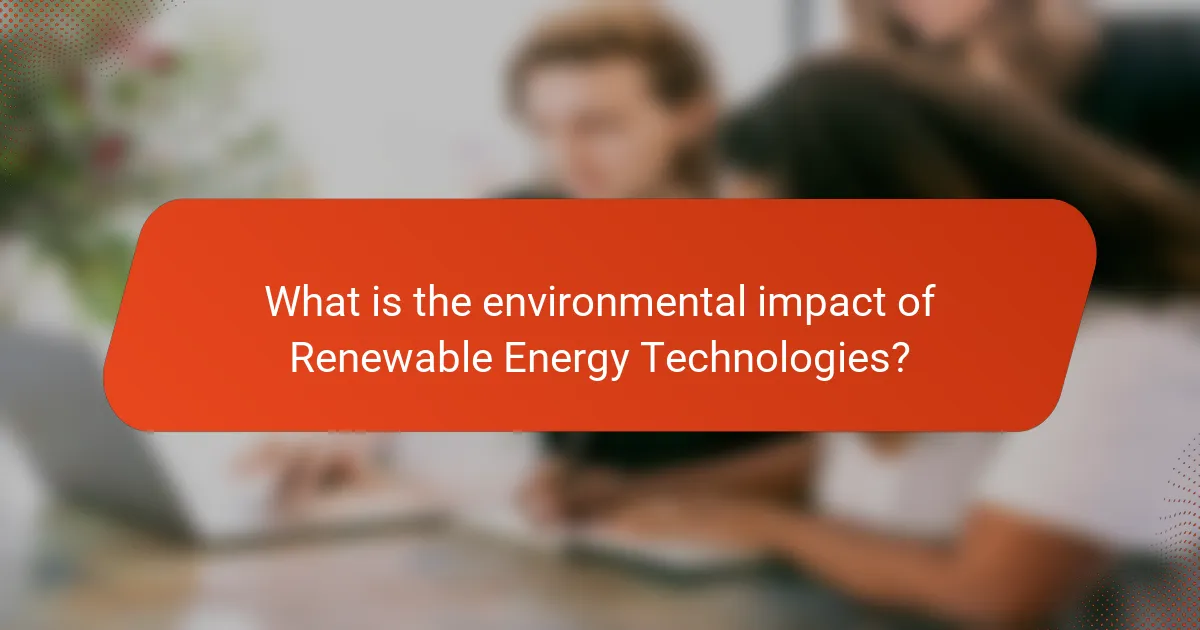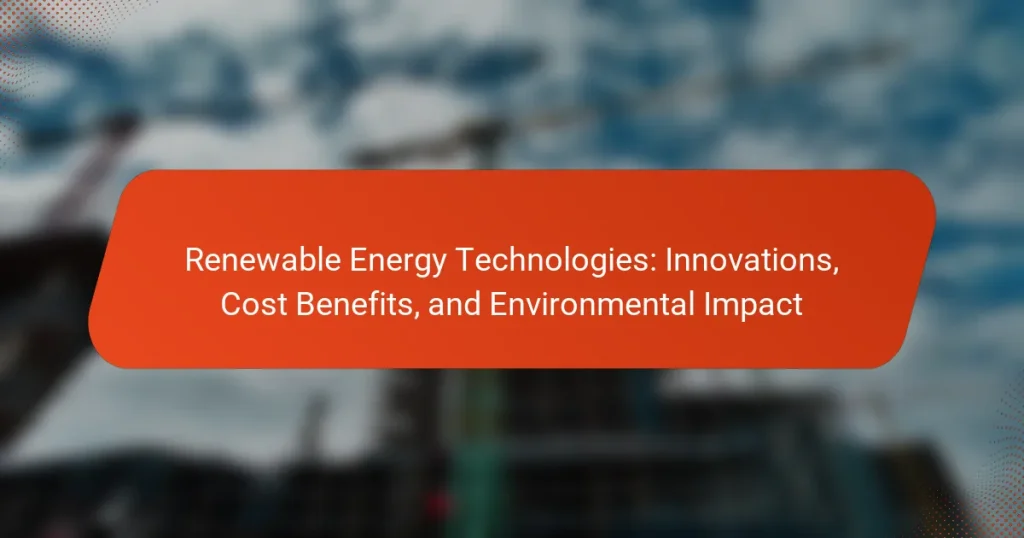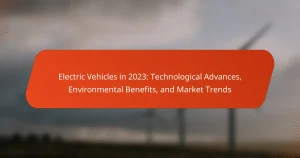Renewable energy technologies encompass systems that harness energy from naturally replenished sources, including solar power, wind energy, hydroelectric power, geothermal energy, and biomass. These technologies offer significant cost advantages, such as reduced operational expenses and lower energy bills, with initial investments decreasing due to technological advancements. Additionally, renewable energy sources contribute to substantial reductions in greenhouse gas emissions and air pollutants, promoting environmental sustainability and public health. The article explores the innovations within renewable energy technologies, their economic benefits, and their positive environmental impacts, highlighting the shift towards a more sustainable energy future.

What are Renewable Energy Technologies?
Renewable energy technologies are systems that harness energy from natural processes that are replenished constantly. These technologies include solar power, wind energy, hydroelectric power, geothermal energy, and biomass. Solar power utilizes photovoltaic cells to convert sunlight into electricity. Wind energy captures kinetic energy from wind using turbines to generate power. Hydroelectric power relies on flowing water to produce electricity through dams. Geothermal energy taps into heat from the Earth’s interior for power generation. Biomass energy converts organic materials into fuel or electricity. According to the International Renewable Energy Agency, renewable energy sources accounted for 29% of global electricity generation in 2020.
How do Renewable Energy Technologies function?
Renewable energy technologies function by converting natural resources into usable energy. Solar panels convert sunlight into electricity through photovoltaic cells. Wind turbines harness wind energy to generate power via rotating blades connected to generators. Hydropower systems use flowing water to turn turbines, producing electricity. Biomass energy is generated by burning organic materials or converting them into biofuels. Geothermal systems utilize heat from the Earth’s core for energy production. Each technology operates based on specific principles of energy conversion, making them sustainable alternatives to fossil fuels. The International Energy Agency reported that renewable energy sources accounted for nearly 30% of global electricity generation in 2020, highlighting their growing significance.
What are the primary components of Renewable Energy Technologies?
The primary components of Renewable Energy Technologies include solar panels, wind turbines, hydroelectric systems, and biomass converters. Solar panels convert sunlight into electricity through photovoltaic cells. Wind turbines harness wind energy to generate power via rotating blades. Hydroelectric systems utilize flowing water to produce electricity, often through dams. Biomass converters transform organic materials into usable energy. Each component plays a crucial role in harnessing renewable resources to generate sustainable energy. These technologies collectively contribute to reducing greenhouse gas emissions and dependence on fossil fuels.
How do these components interact to generate energy?
Renewable energy technologies generate energy through the interaction of various components. In solar energy systems, photovoltaic cells convert sunlight into electricity. Wind turbines use blades to capture wind energy, which spins a rotor connected to a generator. Hydropower systems harness flowing water to turn turbines, generating electricity. Biomass energy involves the combustion of organic materials, releasing stored energy. Each component’s efficiency affects overall energy production. For example, photovoltaic cells have an efficiency rate of around 15-20%. Wind turbines can achieve efficiencies above 40%. These interactions optimize energy generation, contributing to cleaner energy solutions.
What types of Renewable Energy Technologies are available?
Solar energy technologies harness sunlight for electricity or heat. These include photovoltaic cells and solar thermal systems. Wind energy technologies convert wind energy into electricity using turbines. Hydropower technologies generate electricity from flowing water. Biomass energy technologies utilize organic materials for fuel production. Geothermal energy technologies exploit heat from the Earth’s interior for power generation. Ocean energy technologies capture energy from tides and waves. Each type of renewable energy technology contributes to reducing greenhouse gas emissions and promoting sustainability.
What are the characteristics of solar energy technologies?
Solar energy technologies are characterized by their ability to convert sunlight into usable energy. They primarily include photovoltaic cells, solar thermal systems, and concentrated solar power. Photovoltaic cells directly convert sunlight into electricity through the photovoltaic effect. Solar thermal systems capture sunlight to produce heat, which can be used for water heating or space heating. Concentrated solar power uses mirrors or lenses to focus sunlight onto a small area to generate steam for electricity production.
These technologies are renewable and sustainable, reducing reliance on fossil fuels. They have low operational costs once installed and can significantly lower greenhouse gas emissions. According to the International Energy Agency, solar energy capacity has grown rapidly, reaching over 800 GW globally by 2020. This growth reflects advancements in technology and decreasing costs, making solar energy more accessible.
How do wind energy technologies operate?
Wind energy technologies operate by converting kinetic energy from the wind into mechanical energy. Wind turbines are the primary devices used for this conversion. When wind blows, it causes the turbine blades to rotate. This rotation drives a generator that produces electricity. The efficiency of this process depends on factors like wind speed and turbine design. Modern turbines can generate power at wind speeds as low as 3 m/s. According to the U.S. Department of Energy, wind energy accounted for about 8.4% of the total electricity generation in the U.S. in 2020. This statistic highlights the growing role of wind energy in the renewable energy sector.
What are the benefits of hydropower technologies?
Hydropower technologies provide renewable energy, reducing reliance on fossil fuels. They generate electricity through the movement of water, which is a sustainable resource. Hydropower plants have low operational costs after installation. They also produce minimal greenhouse gas emissions, contributing to climate change mitigation. According to the International Hydropower Association, hydropower accounts for about 16% of global electricity generation. This technology enhances energy security by diversifying energy sources. Additionally, hydropower can create reservoirs that provide water supply and recreational opportunities. The flexibility of hydropower allows for quick adjustments to electricity demand.
What are the key innovations in Renewable Energy Technologies?
Key innovations in renewable energy technologies include advancements in solar panels, wind turbines, energy storage, and smart grid technology. Solar panels have seen improvements in efficiency, with some models reaching over 22% efficiency. Wind turbines have been enhanced for greater energy capture, with larger blades and improved aerodynamics. Energy storage technologies, like lithium-ion batteries, have become more efficient and cost-effective, enabling better management of energy supply and demand. Smart grid technology allows for real-time monitoring and management of energy use, optimizing distribution and reducing waste. These innovations contribute to the overall effectiveness and adoption of renewable energy sources globally.
How have advancements in solar panel efficiency impacted the market?
Advancements in solar panel efficiency have significantly impacted the market by reducing costs and increasing adoption rates. Higher efficiency panels convert more sunlight into electricity, which leads to greater energy output per square meter. This improvement makes solar energy systems more attractive to consumers and businesses. As a result, the overall cost of solar energy has declined, with prices dropping by approximately 82% since 2010. Increased efficiency has also spurred competition among manufacturers, driving innovation and further reducing prices. Consequently, more residential and commercial installations have occurred, contributing to a growing renewable energy market. The global solar market is projected to reach $223 billion by 2026, reflecting these advancements in efficiency and their market influence.
What role do energy storage systems play in renewable energy?
Energy storage systems are crucial for renewable energy integration. They store excess energy generated from renewable sources like solar and wind. This stored energy can be used during periods of low generation. For instance, solar energy is abundant during the day but may be needed at night. Energy storage systems help balance supply and demand. This enhances grid stability and reliability. According to the International Renewable Energy Agency, energy storage can increase renewable energy utilization by up to 50%. These systems enable a smoother transition to a low-carbon energy future.
How is smart grid technology transforming energy distribution?
Smart grid technology is transforming energy distribution by enhancing efficiency and reliability. It integrates digital communication and advanced technology into the existing electrical grid. This integration allows for real-time monitoring and management of energy flow. Smart grids facilitate the use of renewable energy sources, such as solar and wind. They enable two-way communication between utilities and consumers. This interaction empowers consumers to manage their energy usage more effectively. According to the U.S. Department of Energy, smart grids can reduce energy losses by up to 30%. Additionally, they improve response times to outages and enhance overall grid resilience.

What are the cost benefits of Renewable Energy Technologies?
Renewable Energy Technologies provide significant cost benefits through reduced operational expenses and lower energy bills. They often have lower maintenance costs compared to conventional energy sources. The initial investment in renewable technologies is decreasing due to advancements in technology and economies of scale. For instance, the cost of solar photovoltaic systems has dropped by over 80% since 2010.
Renewable energy sources, such as wind and solar, have no fuel costs, which can lead to long-term savings. According to the International Renewable Energy Agency (IRENA), renewable energy sources can be cheaper than fossil fuels in many regions. Additionally, government incentives and subsidies can further reduce the financial burden of adopting these technologies.
As a result, businesses and households can achieve energy independence and stability in energy pricing. Overall, these cost benefits contribute to a more sustainable and economically viable energy future.
How do Renewable Energy Technologies compare in cost to fossil fuels?
Renewable energy technologies are generally becoming more cost-competitive with fossil fuels. The cost of solar and wind energy has decreased significantly in the past decade. According to the International Renewable Energy Agency (IRENA), the global weighted average cost of electricity from solar photovoltaic systems fell by 89% between 2009 and 2020. Wind energy costs also saw a reduction of around 70% in the same period. In many regions, renewables are now cheaper than coal and natural gas. A 2021 report from Lazard shows that the levelized cost of energy for onshore wind and solar is lower than that of fossil fuels in several markets. This trend is expected to continue as technology advances and economies of scale improve.
What are the initial investment costs associated with renewable energy?
Initial investment costs associated with renewable energy vary significantly based on the technology. For solar energy, installation costs average around $2.50 to $3.50 per watt. Wind energy projects typically require $1,200 to $1,700 per installed kilowatt. Geothermal systems can range from $2,500 to $5,000 per installed kilowatt. Biomass energy systems might incur costs of $1,000 to $5,000 per kilowatt. Hydropower projects can have costs ranging from $1,000 to $5,000 per installed kilowatt depending on the scale. These costs include equipment, installation, and infrastructure development. According to the International Renewable Energy Agency (IRENA), investment in renewable energy has increased, indicating growing economic viability.
How do long-term savings from renewable energy technologies manifest?
Long-term savings from renewable energy technologies manifest through reduced energy costs and lower maintenance expenses. These technologies, such as solar and wind, have minimal operational costs after installation. For example, solar panels can generate electricity for 25 years or more with little degradation. According to the U.S. Department of Energy, the levelized cost of solar energy has dropped by 89% since 2009. This significant reduction translates into substantial savings for homeowners and businesses. Additionally, renewable energy systems often qualify for tax incentives and rebates, further enhancing cost benefits. Over time, these factors contribute to a more sustainable and economically viable energy landscape.
What financial incentives are available for adopting Renewable Energy Technologies?
Financial incentives for adopting Renewable Energy Technologies include tax credits, grants, and rebates. Tax credits reduce the amount of tax owed for investments in renewable energy systems. For example, the Federal Investment Tax Credit (ITC) allows a 26% credit on solar energy systems installed before 2023. Grants provide upfront funding to cover the costs of renewable energy projects. The U.S. Department of Energy offers various grant programs for innovative energy technologies. Rebates are available from state and local governments, reducing the purchase price of renewable energy systems. Many states have Renewable Portfolio Standards that mandate utilities to purchase a certain percentage of energy from renewable sources, often supported by financial incentives. These incentives aim to lower the initial costs and encourage widespread adoption of renewable energy technologies.
How do government subsidies impact the adoption of renewable energy?
Government subsidies significantly enhance the adoption of renewable energy. They lower the financial barriers for both producers and consumers. Subsidies can take the form of tax credits, grants, or direct payments. These incentives make renewable energy projects more economically viable. For instance, the U.S. solar investment tax credit has led to a 167% increase in solar installations from 2010 to 2019. Additionally, subsidies encourage innovation and competition in the renewable energy sector. Countries that implement substantial subsidies often see accelerated growth in renewable energy capacity. This growth contributes to a reduction in greenhouse gas emissions and promotes energy independence.
What tax benefits can individuals or businesses receive?
Individuals and businesses can receive tax benefits such as credits, deductions, and exemptions. Tax credits directly reduce the amount owed to the government. For example, the Investment Tax Credit (ITC) allows a credit of 26% for solar energy systems installed before 2023. Deductions lower taxable income, such as the Section 179 deduction for equipment purchases. Exemptions can include property tax exemptions for renewable energy installations. Additionally, businesses may benefit from accelerated depreciation on renewable energy assets, allowing them to recover costs faster. These tax incentives encourage investment in renewable energy technologies and support environmental sustainability.

What is the environmental impact of Renewable Energy Technologies?
Renewable energy technologies significantly reduce greenhouse gas emissions. These technologies include solar, wind, hydroelectric, and geothermal energy. They generate power without emitting carbon dioxide during operation. For example, wind energy can reduce emissions by up to 80% compared to fossil fuels. Solar energy systems also contribute to lower emissions, with a reduction potential of around 90%. Additionally, renewable energy technologies decrease air pollutants, improving public health. The transition to renewables can also conserve water, as many traditional energy sources require significant water for cooling. Overall, the environmental impact of renewable energy technologies is largely positive, promoting sustainability and reducing ecological harm.
How do Renewable Energy Technologies reduce greenhouse gas emissions?
Renewable energy technologies reduce greenhouse gas emissions by replacing fossil fuels with cleaner energy sources. These technologies include solar, wind, hydroelectric, and geothermal energy. They generate electricity without burning fossil fuels, which are major contributors to greenhouse gas emissions. For instance, solar power systems convert sunlight directly into electricity, emitting no carbon dioxide during operation. Wind turbines harness wind energy, producing electricity without emissions. According to the U.S. Energy Information Administration, renewable energy sources accounted for about 20% of U.S. electricity generation in 2020, significantly lowering emissions compared to fossil fuels. Transitioning to these technologies can help achieve climate goals and reduce the overall carbon footprint.
What are the lifecycle emissions of different renewable energy sources?
Lifecycle emissions vary among renewable energy sources. Solar energy typically has emissions of about 20-50 grams of CO2 equivalent per kilowatt-hour (gCO2e/kWh). Wind energy emissions range from 10-20 gCO2e/kWh. Hydropower emissions can be around 1-30 gCO2e/kWh, depending on the reservoir and ecosystem impacts. Biomass energy has higher emissions, averaging 30-100 gCO2e/kWh, influenced by land use changes. Geothermal energy emissions generally fall between 5-25 gCO2e/kWh. These figures demonstrate that renewable sources have significantly lower lifecycle emissions compared to fossil fuels, which average over 800 gCO2e/kWh.
How does renewable energy contribute to biodiversity conservation?
Renewable energy contributes to biodiversity conservation by reducing greenhouse gas emissions. This reduction mitigates climate change, which is a significant threat to ecosystems. Renewable energy sources, such as solar and wind, have a smaller ecological footprint compared to fossil fuels. They help preserve habitats by minimizing land degradation and pollution. For instance, transitioning to renewable energy can decrease air and water pollution levels. Cleaner environments support healthier ecosystems and diverse species. Additionally, renewable energy projects can be designed to coexist with wildlife, promoting habitat protection. Studies show that renewable energy can lead to a net positive impact on biodiversity when implemented responsibly.
What are the potential negative impacts of Renewable Energy Technologies?
Renewable energy technologies can have several potential negative impacts. These impacts include land use changes, which can disrupt local ecosystems. For instance, large solar farms require significant land, affecting habitats. Wind turbines can pose threats to bird and bat populations due to collisions. Additionally, the production of renewable energy technologies can involve toxic materials. For example, the manufacturing of solar panels may use hazardous chemicals. There are also concerns regarding the disposal of these technologies at the end of their life cycle. Improper disposal can lead to environmental contamination. Furthermore, renewable energy sources can be intermittent, leading to reliability issues in energy supply. This intermittency can necessitate backup systems, which may rely on fossil fuels.
What environmental concerns are associated with solar energy production?
Solar energy production raises several environmental concerns. The manufacturing process of solar panels involves toxic chemicals. These substances can lead to air and water pollution if not managed properly. Additionally, the disposal of old or damaged solar panels poses a waste management challenge. Solar farms can also disrupt local ecosystems and wildlife habitats. Land use for large solar installations may lead to habitat loss. Furthermore, the mining of raw materials for solar panels can result in significant environmental degradation. These factors highlight the need for sustainable practices in solar energy production.
How can wind energy technologies affect local wildlife?
Wind energy technologies can significantly affect local wildlife. The construction and operation of wind farms can lead to habitat disruption. Birds and bats are particularly vulnerable to collision with turbine blades. A study published in the journal “Ecological Applications” found that wind turbines can cause mortality rates in certain bird species. Additionally, the noise and movement of turbines may disturb wildlife behaviors. Research indicates that some species may alter their migration patterns due to wind farm presence. In contrast, wind energy can reduce greenhouse gas emissions, benefiting ecosystems in the long term. Balancing wind energy development with wildlife conservation is crucial for minimizing negative impacts.
What best practices should be followed when implementing Renewable Energy Technologies?
Implementing Renewable Energy Technologies requires adherence to several best practices. First, conduct a thorough feasibility study to assess local resources and needs. This ensures that the technology aligns with regional energy demands. Second, engage stakeholders early in the planning process. This includes local communities and government entities to foster support and collaboration. Third, prioritize the selection of appropriate technology based on site-specific conditions. For example, solar panels are best suited for sunny regions, while wind turbines thrive in areas with consistent winds.
Fourth, ensure compliance with environmental regulations and standards. This minimizes negative impacts on local ecosystems. Fifth, invest in training for personnel involved in installation and maintenance. Skilled workers enhance the efficiency and longevity of renewable energy systems. Sixth, implement a monitoring and evaluation system to assess performance over time. Regular assessments help in optimizing operations and addressing issues promptly.
Lastly, secure funding and incentives to support initial investments. Government grants and subsidies can significantly reduce financial barriers. These practices collectively enhance the successful implementation of Renewable Energy Technologies, leading to sustainable energy solutions.
Renewable Energy Technologies encompass systems that harness energy from constantly replenished natural processes, including solar, wind, hydroelectric, geothermal, and biomass sources. The article provides an overview of how these technologies function, their primary components, and their interactions in energy generation. It also highlights the cost benefits, financial incentives, and innovations driving their adoption, while addressing the environmental impacts, including greenhouse gas emissions reduction and potential negative effects on wildlife. Key insights into the lifecycle emissions and best practices for implementation are also discussed, emphasizing the importance of sustainable energy solutions.




